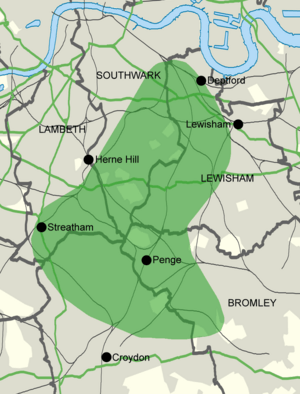Great North Wood facts for kids
The Great North Wood was a huge natural oak woodland near London. It started about 3 miles (5 km) south-east of central London. This ancient forest grew along the Norwood Ridge.
At its biggest, the wood stretched far. It reached almost to Croydon in the south. To the north, it went as far as Camberwell. Even in the Middle Ages, there were already large open areas within the wood. These clearings were home to small villages like Penge and Dulwich.
Today, only small parts of the Great North Wood remain. These include places like Dulwich Wood, Sydenham Hill Wood, Biggin Wood, and Beaulieu Heights. Many local place names still remind us of this old forest. For example, you'll find South Norwood, Upper Norwood, and West Norwood. Other names like Woodside, Forest Hill, and Honor Oak also show the area's woodland past.
Contents
The Great North Wood's Past
How Old Is the Great North Wood?
The first time the wood was written about was in 1272. This was found in old court records called assize records. Later, during the time of King Edward III, the Whitehorse family owned it.
In the 1600s, Oliver Cromwell took control of the wood from the Archbishop of Canterbury. At that time, it was about 830 acres (3.4 square kilometers) big. However, it only had about 9,200 oak trees that had been cut back (called pollards).
How People Used the Wood
For hundreds of years, people managed the Great North Wood. They used it to get valuable things. For example, they cut down trees (called coppices) to get timber. They also made charcoal and collected oak bark. Smaller pieces of wood were also gathered.
The open areas, called commons and pastureland, were used for grazing animals. People also collected turf and firewood there.
Wood for Ships and Leather
Big oak trees were used to build ships. This timber went to the Royal Dockyard in Deptford. This dockyard was set up in 1513. The oak bark was taken to Bermondsey to make leather. There, it was boiled to get out special chemicals called tannins. These tannins were used in the leather-making process.
Making Charcoal for Fuel
Oak and hornbeam trees were cut back every 10-20 years. This wood was then used to make charcoal. Charcoal was made in cone-shaped kilns right in the wood. People called colliers oversaw this process. They then sold their charcoal in markets.
Charcoal was the main fuel for bakeries and kitchens for a long time. This was because King Edward I had banned using coal from northern England. He said it made too much smoke. In 1870, a historian named Andrew Ducarel noted that Croydon was "surrounded with hills well covered with wood, whereof great store of charcoal is made."
Important Boundary Trees
Some old oak trees were kept to mark the edges of different parishes. The most famous of these was the Vicar's Oak. This tree marked where four old parishes met: Lambeth, Camberwell, Croydon, and a part of Battersea parish (the area of Penge).
Today, this spot is where Westow Hill and Anerley Hill meet, near Crystal Palace Park. It's where four London boroughs meet: Lambeth, Southwark, Croydon, and Bromley. A writer named John Aubrey mentioned this "ancient remarkable tree" in 1718, saying it was already gone. But another person, JB Wilson, said the Vicar's Oak lasted until 1825.
Another special oak tree was the Question Oak at Westwood. This was at the home of Charles Spurgeon. He would challenge his students to ask questions about religious topics under this tree.
The Wood Shrinks Over Time
By 1745, a map by John Rocque showed the wood was only about 3 miles (5 km) wide. Much of it had been turned into farmland or common land. This happened in places like Croydon, Penge, Streatham, Knight's Hill, Dulwich, and Westwood.
Private landowners also cleared a lot of the remaining wood. For example, in the south, this happened after the 1797 Croydon Inclosure Act. More land was cleared in the center-west when Lord Thurlow's estates were sold in 1806.
Other fun places, like the pleasure gardens at Knight's Hill and the Spa on Beulah Hill, also disappeared. They were replaced by new houses during the Victorian era. The famous The Crystal Palace and its park became a major attraction. The park is now home to a big UK athletics ground.
Stories from the Past
Visitors and Residents
On August 11, 1668, Samuel Pepys wrote about visiting fortune tellers in these woods. He said his wife and friends went "to see the Gypsies at Lambeth, and have their fortunes told." People reported that a group of gypsies lived there continuously. Police broke up their camp during the first land enclosures.
In 1722, Daniel Defoe wrote about the area. He said it was "more open and more woody than any other part so near London." He was talking about areas around Norwood, Camberwell, Dulwich, and Lewisham.
As late as 1802, a hermit known as "Matthews the hairyman" lived in the wood. He lived in a cave or a "dug-out home" within the forest.
The Great North Wood Project
In 2017, the London Wildlife Trust received money from the Heritage Lottery Fund. This was for a four-year project about the Great North Wood. The project aims to make people aware of this mostly forgotten woodland. It also encourages local residents to explore, enjoy, and value the nature around them.
The Trust has chosen 13 woods where they are working to improve the habitats. These places include:
- New Cross Gate Cutting
- One Tree Hill
- Dulwich Wood
- Sydenham Hill Wood
- Hillcrest Wood
- Crystal Palace Park
- Streatham Common
- Convent Wood
- Biggin Wood
- Spa Wood (The Lawns)
- Beaulieu Heights
- Grangewood Park
- Long Lane Wood


